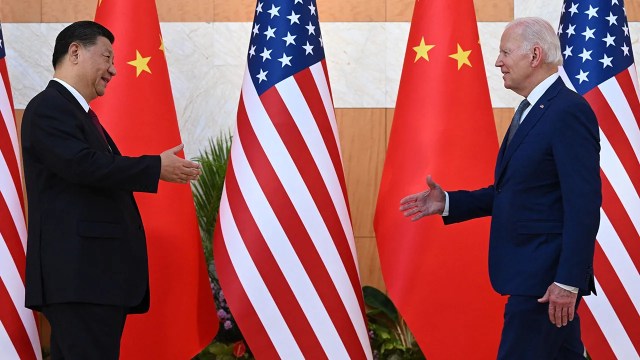
People in 23 countries tend to see U.S. President Joe Biden more positively than Chinese President Xi Jinping, according to a Pew Research Center survey conducted in spring 2023. A median of 54% have confidence in Biden to do the right thing regarding world affairs, compared with 19% who say the same of Xi.
This Pew Research Center analysis explores global public opinion of the United States, China and their respective leaders over time. The focus is on the difference between the shares in a given country who say they have a favorable view of the U.S. and China as well as the difference between the shares who say they have confidence in the U.S. or Chinese leader at the time. We rely on nearly two decades of trends on these questions. Because certain countries were not surveyed in particular years, some flags will appear and disappear from the graphics accordingly. Country classifications by income level reflect 2022 World Bank income groupings.
The 2023 data is drawn from 24 nationally representative surveys conducted with 30,861 adults. Data from the U.S. is not included in the analysis of confidence in leadership. The surveys were conducted from Feb. 20 to May 22, 2023. Surveys were conducted over the phone with adults in Canada, France, Germany, Greece, Italy, Japan, Netherlands, South Korea, Spain, Sweden and the United Kingdom. Surveys were conducted face-to-face in Argentina, Brazil, Hungary, India, Indonesia, Israel, Kenya, Mexico, Nigeria, Poland and South Africa. In Australia, we used a mixed-mode probability-based online panel. In the U.S., everyone who took part in this survey is a member of the Center’s American Trends Panel (ATP). Methodologies for each survey country and year are publicly available.
Since 2020, surveys in the U.S. and Australia have been conducted online; all prior surveys in both countries were conducted by telephone. Since 2020, the Italy survey has been conducted by telephone; previous surveys in Italy included in this analysis were conducted face-to-face. Since 2021, the Greece survey has been conducted by telephone; all prior surveys in Greece were conducted face-to-face.
Difference in shares who say they have confidence in the U.S. and Chinese presidents to do the right thing regarding world affairs
Particularly in high-income countries, the gap in these views can be quite large. In Poland, for example, people are 75 percentage points more likely to rate Biden positively than Xi. In Germany, Japan and Sweden, the gap is at least 50 points. Views of the two leaders are more comparable to one another in middle-income countries, but even in most of these places, more have confidence in Biden than Xi. Indonesia and Hungary are two notable exceptions where the leaders receive nearly identical marks.
Related: Comparing Views of the U.S. and China in 24 Countries
These gaps in views of the American and Chinese leaders reflect both souring attitudes toward Xi in high-income countries and greater confidence in Biden – particularly compared with his predecessor, Donald Trump. Indeed, for much of his presidency, Trump received lower marks than Xi in many places surveyed.
This also happened at the end of the Bush era in 2007, when limited confidence in then-President George W. Bush and relatively positive ratings for China’s then-President Hu Jintao led to more positive ratings for Hu than Bush in most places.
Favorability of the U.S. and China
This year, overall views of the United States are much more positive than views of China in most places surveyed. A median of 59% offer positive evaluations of the U.S., compared with a median of 28% who say the same of China. But this has not always been the case in our nearly two decades of favorability polling, and views of the countries have fluctuated alongside views of their leaders.
Difference in shares who say they have favorable views of the U.S. and China
Toward the end of the Bush era in 2007, with lower ratings for the U.S. and relatively positive views of China, many countries surveyed had gaps around 10 points or smaller in their views of the two superpowers. In some countries, such as France and Argentina, people even had slightly more positive views of China than the U.S.
During the Obama era, views of the U.S. turned substantially more positive in most countries surveyed, while views of China changed little or became more negative. The changes led to a larger gap in views of the two countries, with people in most places surveyed expressing a more favorable view of the U.S. than of China by 2016.
With Trump’s presidency, things shifted dramatically. Favorable views of the U.S. nose-dived in most places surveyed in 2017, and the two countries were, once again, seen in a relatively equal light in many places. In some others, people again saw China slightly more favorably. But, by 2020, as the COVID-19 pandemic spread, favorable views of both China and the U.S. had fallen to near historic lows in most places surveyed. Still, the U.S. received a slightly more positive assessment than China in many countries, though both were generally seen quite negatively.
Since the beginning of Biden’s presidency, views of the U.S. have rebounded dramatically in many of the countries surveyed, while views of China remain among their most negative, leading to some of the largest gaps in these views we have seen in our polling.



